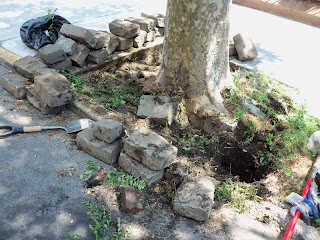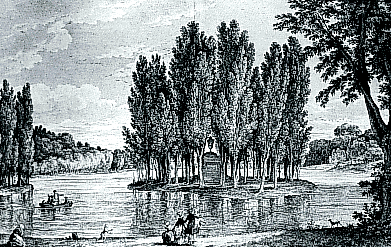A genus of 3 species of handsome conical evergreen trees related to the Cypress that are native to the western U.S. and southeast Asia.
The timber is valuable for shingle tiles and pencils.
They prefer full sun but tolerate part shade, thriving on deep, fertile, well drained, neutral to acidic soil. Prefers a site sheltered from excessive winds and abundant moisture however is drought tolerant.
Young trees should be pruned to a single leader ensuring better form, snow and ice tolerance. Insect pests and disease problems in the landscape are usually minor however can include Incense Cedar Scale and rust disease.
Propagation is from seed germinated in containers and protected from frost for the first winter; also from half hardened cuttings in summer.
Calocedrus decurrans ( Incense Cedar )
A beautiful, fast growing large, very dense columnar tree exceeding 100 feet that is native to mountain forests of western North America from northern Oregon to southern California.
Very old trees may develop a rounded crown.
Some record include: fastest recorded growth rate - 4 feet; 4 years - 9 feet; 5 years - 13 feet; 10 years - 27 x 6 feet; 20 years - 36 x 17 feet; 75 years - 112 feet; largest on record - 235 x 70 feet with a trunk diameter of 16 feet; largest in California - 152 x 50 x 12.2 feet @ Sawyers Bar; largest in England - 133 feet with 7 foot diameter; largest in Georgia - 120 x 40 x 5.7 feet; largest in Delaware - 93 x 33 x 4 feet; largest in Maryland - 85 x 45 feet in Annapolis; longest lived - 1000 years.
This tree grows over a long season from May into August.
Unfortunately rare in the cultivation in the U.S. It can be found in Washington, D.C. at the National Zoo near the lion and tiger exhibits, the Washington Cathedral and at Rock Creek Cemetary.
The tiny aromatic, sharp pointed triangular, up to 0.5 inch leaves in whorls of 4 closely pressed against the stems are glossy deep green. The foliage is borne on flattened sprays.
The shoots turn red-brown after a single season.
The fibrous red-orange to cinnamon brown bark becomes deeply ridged and furrowed with age.
The tiny pollen cones on the tips of the branches are bright green and are followed by erect oblong cones, up to 1 inch, that ripen to reddish-brown.
Hardy zones 4 to 9 tolerating as low as -33 F. Despite its native range, the Incense Cedar grows very well over a huge swath of eastern North America. It is free of pests and also tolerant of heat, drought, urban conditions, pollution, snow and ice, in fact - it loves hot summers! The Incense Cedar prefers a soil PH from 4.5 to 7.
USDA-NRCS PLANTS Database* photos taken on 4th of July 2010 @ U.S. National Arboretum, D.C.

 * videos found on Youtube
* videos found on YoutubeAureovariegata
Columnar in habit with mid-green foliage that is attractively splashed yellow. Same growth rate and mature size as species.
Columnaris
More narrow and columnar than the species ( 10 years - 14 x 2 feet ( average ); 20 years - 40 x 6.6 feet ) making it an excellent choice for backgrounds and formal plantings.
Maupin Glow
Forms a fast growing, columnar tree with glowing bright yellow foliage that eventually turns to verdant bright green.
It is destined to become an extremely popular landscape tree as it is a true beauty.
Mature size unknown though I suspect it can eventually grow large.
One of my favorite conifers!!!
* photos taken on 4th of July 2010 @ U.S. National Arboretum, D.C.

Calocedrus formosana ( Taiwanese Incense Cedar )
Very similar to Calocedrus macrolepis and is considered a regional variant of it by some botanist. The very attractive foliage is deep blue-green above and white banded beneath.
A very large tree, old growth trees in its native mountain forests of Taiwan have been known to reach as large as 120 feet in height with a trunk diameter of 10 feet.
Hardy zones 8a to 10, thriving in the southeastern U.S. It is difficult to propagate from cuttings however easier from seed.
Celocedrus macrolepis ( Chinese Incense Cedar )
A very ornamental fast growing large tree reaching around 80 feet that is native to southwest China, northern Vietnam, northern Thailand, northern Burma and northern Laos where it is rare over its entire range. With ascending and spreading branches, they are pyramidal when young and broadly spreading with age. Some records include: fastest recorded growth rate - 3 feet; 2 years - 28 inches; 10 years - 10 x 6 feet; largest on record - 135 x 60 feet with a trunk diameter of 10 feet.
The small, triangular leaves pressed against the stems are bright green above and blue-white beneath. The foliage is borne on larger, flatter sprays than Calocedrus decurrens.
The elliptical cones are up to 0.5 inches and are orange-brown covered with a purplish bloom.
The pale gray bark is scaly.
Likely hardy zones 5 to 8, it has not been fully tested in the U.S. but is very heat tolerant and is reported to grow very well in the southeastern U.S. It is difficult to propagate from cuttings however easier from seed.
CLOSE RELATIVES:
Libocedrus chilensis ( Chilean Incense Cedar )
Also called Austrocedrus chilensis, is an attractive medium size tree that is native to moist forests of southern Chile and Argentina where it is unfortunately dying off due to the introduced Lateralis Root Rot ( the same fungus that is killing Lawson Cypress in the western U.S. ). The Chilean Incense Cedar is columnar when young, later becoming oval in shape with age. Generally moderately fast growing, some records include: fastest recorded growth rate - 3 feet; 10 years - 10 x 4 feet ( average ); largest on record - 100 x 30 feet with a trunk diameter of 6.5 feet; longest lived - 1500 years.
The flattened scale-like foliage up to 0.25 inches is glossy deep green with blue-white flecks that give the foliage a blue-gray cast. The foliage in flattened sprays is white banded beneath.
The flowers at the stem tips are very small and yellow, borne in early spring.
They are followed by oblong seed cones that are up to 0.5 inches in length.
The scaly orange-brown bark peels in narrow strips.
Hardy zone 7 to 9 ( tolerating as low as 0 F ).
Prefers full sun to partial shade and a site protected from excessive wind on deep, moist, acidic, well drained soil. Prefers a maritime climates with cool summers and abundant rainfall all year, similar to that of the British Isles where it thrives.
Libocedrus arkfas ( Papua Cypress )
Also called Papuacedrus arkfas and Libocedrus papuana, is native to New Guinea and reaches a maximum size of 170 feet. Hardy north to zone 8
Libocedrus bidwillii ( Pahautea )
A slow growing, slender, upright, large conifer native to mountains up to 6000 feet in elevation in New Zealand where it is endangered to extinct in wild. Some records include: 5 years - 7 x 2 feet; largest on record - 100 x 50 feet with a trunk diameter of 4 feet.
The compressed, scale-like leaves are deep green. The foliage is borne on feathery sprays.
The bark is exfoliating.
Hardy zones 6 to 10; it is moderately drought tolerant and very wild tolerant. Prefers moderately cool summers and grows in the British Isles.
Libocedrus plumosa ( Kawaka )
A beautiful, slow growing, upright-conical tree, reaching around 75 feet, that is native to New Zealand where it is rare. Some records include: 10 years - 13 feet; largest on record - 110 feet with a trunk diameter of 5 feet. It can also be used as a container plant.
The compressed, flattened, scale-like leaves up to an inch in length give this fine conifer a soft feathery appearance.
The beautiful deep red bark is similar to that of Carya ovata Shagbark Hickory.
Hardy zones 8 to 10 preferring moderately cool summers and grows in the British Isles. Very wind tolerant and moderately drought tolerant.
Pilgerodendron uviferum ( Patagonia Incense Cedar )
Also called Libocedrus tetragona, reaches a maximum size of 180 feet with 3.5 foot trunk diameter and is native to southern Chile and southwest Argentina where it occurs further south than any other conifer worldwide. It grows wild in the Valdivian temperate rain forests and Magellanic subpolar forests where it tolerates and even prefers very cool summers. Slow growing and narrow in habit, it can live up to 500 years.
Outside its native range, it grows well in Ireland where it reaches up to 20 feet and may eventually become much larger.
Flood tolerant, it even grows in standing water.
Hardy north to zone 6
 With wildlife and people living together, it is common to see deer in neighborhoods all around Austin. The deer can really give headaches to the novice landscaper. When Landscaping in Austin, it is important to know the different types of shrubs and perennials you can use to make your yard beautiful and keep the deer from munching on your new plantings. Remember, the Plants mentioned are usually deer Resistant, but deer will eat almost any plant if hungry in extreme drought conditions.
With wildlife and people living together, it is common to see deer in neighborhoods all around Austin. The deer can really give headaches to the novice landscaper. When Landscaping in Austin, it is important to know the different types of shrubs and perennials you can use to make your yard beautiful and keep the deer from munching on your new plantings. Remember, the Plants mentioned are usually deer Resistant, but deer will eat almost any plant if hungry in extreme drought conditions.




































